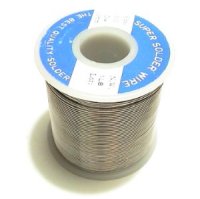Call Us Now:
0345 193 0615
 Soldering: A group of processes that join metals by heating them to a suitable temperature below the solidus of the base metals and applying a filler metal having a liquidus not exceeding 450 °C (840 °F). Molten filler metal is distributed between the closely fitted surfaces of the joint by capillary action.
Soldering: A group of processes that join metals by heating them to a suitable temperature below the solidus of the base metals and applying a filler metal having a liquidus not exceeding 450 °C (840 °F). Molten filler metal is distributed between the closely fitted surfaces of the joint by capillary action.There is no doubt that good soldering is the key to the creation of high quality leads and cables, but it is a skill that has to be learned and which requires a keen eye and some physical dexterity. If the soldering is done well a good connection is made and the cables function as intended. If the soldering is done badly, it can result in all sorts of problems ranging from unwanted noise (buzzes and hums) to the total destruction of the connected equipment and even death!
Many types of leads and cables made from copper require soldering to fit the connectors, and even those with crimp connectors may require that the end of the cable is tinned (covered in solder) before or after the connectors are fitted.
Leads Direct can take all the problems and hassle away from those who don’t need or want to develop the skill themselves – we can supply hundreds of types of leads and cables ready made, including musical leads such as instrument leads, midi leads, and microphone leads, computer cables including monitor leads, keyboard and mouse leads, serial cables, and computer audio cables as well as Hi-Fi and Home Cinema leads, in fact if it is a cable we can probably supply it. We can even manufacture custom cables to your own specification if a standard cable is not what you need… Whatever you choose you can be sure that you get the right lead at a great price and save yourself all the work!
For those who like to do the work themselves, we can supply the cable, the connectors, and even the tools needed to do the job properly. In addition our Technical Library pages (of which this is one) contains technical information on the pinouts and connections required for various types of cable along with wiring diagrams where appropriate – see the pages on DIN wiring, Network wiring, S-Video wiring, SCART wiring and Serial wiring for more information. If you don’t find the information you want, please ask and we will try to locate and publish it in the Technical Library section.
in the menu to the left and below are links to some useful pages on soldering, the soldering tools and working conditions necessary to do the job correctly, and even an essay on the forthcoming regulations that will undoubtedly change how soldering is done in UK and Europe.
Prepare to say farewell to an old friend A historical article in which Martin Hickman writes about the proposed changes to regulations on Solder that came into force during 2006… The words ‘Health & Safety’ produce a reaction in most … Continue reading
Alan Winstanley covers the basics of soldering in this first instalment of an article in three parts originally reproduced by Everyday Practical Electronics magazine © Alan Winstanley 1997-2010 Introduction The first and most important aspect of assembling any electronic project is … Continue reading
Alan Winstanley covers how to actually solder in this second instalment of an article originally reproduced by Everyday Practical Electronics magazine © Alan Winstanley 1997-2010 How to solder Turning to the actual techniques of soldering, firstly it’s best to secure … Continue reading
Alan Winstanley covers a quick summary plus tips on trouble shooting solder joints and safety in this third instalment of an article originally reproduced by Everyday Practical Electronics magazine © Alan Winstanley 1997-2010 Quick Summary Guide To round off our practical … Continue reading
Soldering: A group of processes that join metals by heating them to a suitable temperature below the solidus of the base metals and applying a filler metal having a liquidus not exceeding 450 °C (840 °F). Molten filler metal is distributed … Continue reading
Alan Winstanley covers a quick summary plus tips on trouble shooting solder joints and safety in this third instalment of an article originally reproduced by Everyday Practical Electronics magazine © Alan Winstanley 1997-2010 Quick Summary Guide To round off our practical … Continue reading
Soldering requires a number of tools, and an appropriate, well lit and properly ventilated working area. Leads Direct sells a huge range of such tools and associated products which you can view and purchase. There are also safety requirements to take into … Continue reading
Alan Winstanley covers a quick summary plus tips on trouble shooting solder joints and safety in this third instalment of an article originally reproduced by Everyday Practical Electronics magazine © Alan Winstanley 1997-2010 Quick Summary Guide To round off our practical … Continue reading
The perfect solder joint is a wonder to behold, and indicates a proper connection that will give years of sterling service. Since Leads Direct specialises in leads and cables of all types, we will choose a Jack connection as used … Continue reading